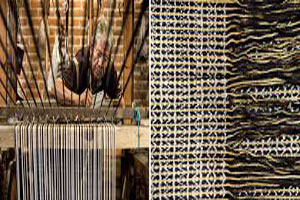
Tribute to traditional Mexican shawl at London show
YarnsandFibers News Bureau 2014-08-04 15:30:00 – LondonThe traditional Mexican `rebozo` a laborious hand woven shawl which was popularized by Frida Kahlo, the late Mexican painter is the focus of the "Made in Mexico" exhibit at the Fashion and Textile Museum in London.
The exhibit explores the role that fashion has played in promoting Mexican culture worldwide from the 17th century to the present and highlights the rebozo as a symbol of Mexican identity. It is unclear when the first rebozos were woven, although the first references to this garment appear in the 16th century.
The origins of the rebozo, came in a variety of designs and colours, date to the colonial era when Mexican artisans were influenced by embroidered shawls and `mantillas` (lace/satin veil worn over head and shoulders) from Spain.
The classic rebozo is made of cotton, silk, rayon/cotton and wool. Its marbled pattern is created with the ikat technique. IKAT is of Malay origin, is a yarn tie-dye technique. The communication and trade with Orient in 1565 through the Acapulco galleon, when it landed in Mexican shores, the Persian xal and Hindu sari influenced the decoration of the Mexican rebozo.
They were made famous by Kahlo, several of her portraits show her wearing the rebozo. She wore the rebozo as a symbol of Mexican identity.
To create a rebozo is a labour-intensive process, and one which requires knowledge of traditional production methods. The Museum brings this out in great detail with details on the various stages such as winding, placing the threads, soaking and weaving.
Not only is this crucially informative but gives you such respect for the garments on show.
"Made in Mexico" also features work by contemporary Mexican and British artists, photographers, fashion and textile designers.
The exhibition Made in Mexico opened June 6 and will continue till Aug 30. After this exhibition closes in London it travels to the Franz Mayer Museum in Mexico City, where it will open in Spring 2015.
Market Intelligence
Ask for free sample Report

experience
Customer Base
dedicated team
Countries Served Worldwide









